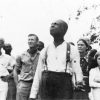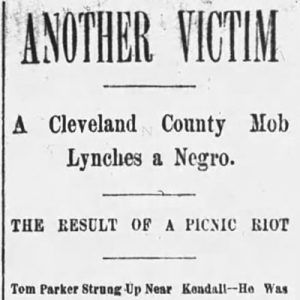calsfoundation@cals.org
Tom Parker (Reported Lynching of)
On October 14, 1897, an African American man named Tom Parker was reportedly lynched in Cleveland County for participating in a riot at an August picnic near Kendall’s mill. While many newspapers refer to Parker as the third person to have been lynched after the incident, the only other reported lynching as a result of the incident was that of Bill Wiley (also referred to as Bill Wiley Douglass and Bill Wyatt), who was lynched in late August. Newspapers ultimately concluded that Parker had not been lynched.
The earliest report of the Kendall incident appears in the Pine Bluff Daily Graphic on August 22. On Saturday, August 21, a group of African Americans had a picnic near the Kendall mill in Cleveland County. A number of the attendees worked at Kendall’s mill, and when they failed to appear for work, T. T Johnson, who worked at the mill, went to the picnic to find them. He had an altercation with one of the men, who drew a knife and slit Johnson’s throat. Johnson eventually died. An additional white man, C. T. Gray, argued with someone at the picnic and was also knifed. No suspect had been captured, but it was reported that “the community is aroused and citizens are out searching for him.”
On August 25, the Arkansas Gazette published a story datelined Pine Bluff (Jefferson County), August 24. According to the Gazette, on August 23, two Black men had been arrested for the crimes. While being taken to the jail in Rison (Cleveland County), one escaped, and the other, identified as Bill Wiley Douglass, was hanged from a trestle on the Cotton Belt Railroad. Six others had been jailed in Rison for participating in what was described as a “riot,” and as the jail was not very safe, it was reported that “it is the general opinion that before morning all six will be suspended between terra firma and the clouds.” Although numerous newspapers across the country reported that this sextuple lynching had occurred, two of the men were subsequently released, and the other four were moved to the jail in Camden (Ouachita County) and still later to Pine Bluff.
The August 29 edition of the Arkansas Gazette gives a more extensive picture of the incident, this time omitting that T. T Johnson had gone to the picnic to find missing workers, changing the account of Johnson’s injuries, and leaving out all mention of C. T. Gray. Reportedly a group of around 500 African American workers from two large lumber mills, Kendall’s mill and Bluff City, were having a picnic on Big Creek near Kendall’s. The picnickers had put up a pavilion for dancing. A number of curious area whites went to the picnic to view the scene. Most of them left in the late afternoon, but five or six remained. Around dark, a white man named T. T. Johnson went to the picnic to buy some barbecue. While he was there, another white man named Tom Handley tried to get into the dancing pavilion. Handley encountered an African American man named Moranzo Smith, with whom he had had an earlier altercation. Smith took offense and attacked Handley. Johnson intervened and offered to take Handley off the premises. Smith then hit Johnson over the head and crushed his skull. A dozen African Americans then attacked Handley and Johnson.
A melee ensued, lasting around fifteen minutes, during which most of the other Black attendees fled. Johnson and Handley were severely injured, and some white men who happened to be passing cared for them. The following morning, Sheriff S. S. Dykes was informed and formed a posse to pursue the alleged murderers. On Tuesday night, they captured two of the Black men believed responsible. One of them escaped, but one of the ringleaders, identified here as Bill Wiley, was captured by authorities, who set out to return him to Rison on a hand car.
When the group arrived at the Cotton Belt Railroad trestle, which was halfway between the two mills, they were stopped by a mob, which hanged Wiley from the trestle. Moranzo Smith and another African American, identified only as Matthews, were still at large. This account says that only five men had been arrested for participating in the riot; Wiley Strickland, Sam Parker, Will Young, Will Evans, and Alex Turner appeared at a preliminary hearing, after which Evans and Turner were released and the other three were jailed.
Newspapers across the country, including the Topeka State Journal, reported that six men had in fact been arrested and later lynched. According to the Journal, while “information was hardly obtainable,” reports from railroad passengers traveling from Pine Bluff to Little Rock (Pulaski County) confirmed that a lynching had occurred. The San Francisco Call, however, was a bit more restrained in its account, reporting that the “wholesale lynching in Cleveland County proves to have been premature, though it is liable to occur at any time.” The sheriff was pursuing several other alleged ringleaders, including B. O. Smith, Frank Matthews, Frank Wright, and George Callahan. According to the Houston Daily Post, on August 31, Governor Daniel Webster Jones issued a reward of $50 each for fugitives Lorenzo Smith, Forrest White, Dan Matthews, and George Hall.
On October 14, the Pine Bluff Daily Graphic reported that Tom Parker, implicated in the riot, had escaped while being taken from the Jefferson County Jail back to Cleveland County to be tried. It is unclear whether this is the “Sam Parker” referred to in the original arrest reports. The constable escorting Parker had Parker’s hands tied, but he jumped from the buggy near Kedron (Cleveland County) and ran into the woods. On October 15, the Gazette reported that Parker had been lynched near Kendall, the third to “meet a violent death as the result of the picnic riot.” Apparently, Parker had been accused of participating in the riot, but no evidence was found, and he was released. In early October, a group of Black whitecaps tried to chase Parker out of Cleveland County, and Parker shot at one of them and killed him. He was again arrested, but after a hearing in Rison, he was cleared on the grounds of self-defense.
He was arrested again on October 14, but that night he was taken out and lynched, supposedly by friends of the whitecaps who had attacked him. Brief reports on the lynching also appeared in several national newspapers, including the Washington County Hatchet.
On October 17, however, the Gazette expressed some doubts as to Parker’s fate. Noting that their own “thoroughly reliable correspondent” had reported the lynching, they considered the matter closed. A telegram to the Gazette from the Pine Bluff Daily Graphic had apparently confirmed the lynching. The Gazette then referred to the Rison Bazoo, which also confirmed the lynching.
According to the Gazette, the Rison Herald, however, reported that Parker had escaped, “though it is generally supposed his body is still somewhere in that vicinity.” The Gazette then declared that the only way to settle the matter was “to hear the testimony of Mr. Parker. If he is hung let him come forward and say so; if not, keep quiet about it.” The final word on the subject seems to come from the January 27, 1898, edition of the Arkansas Democrat, which, in commenting on the Chicago Tribune’s lynching list for 1897, reported that Parker had not been lynched. Unfortunately, they did not, as they did in other cases, give any justification for their conclusion.
For additional information:
“Another Victim.” Arkansas Gazette, October 15, 1897, p. 1.
“The Chicago Tribune’s Statement.” Arkansas Democrat, January 27, 1898, p. 2.
“Escaped.” Pine Bluff Daily Graphic, October 14,1897, p. 6.
“From Ear to Ear!!!” Pine Bluff Daily Graphic, August 22, 1897, p. 1.
“Hung or Unhung.” Arkansas Gazette, October 17, 1897, p. 4.
“Kendall Mills Killing.” Arkansas Gazette, August 29, 1897, p. 1.
“Lynching in Prospect.” San Francisco Call, August 26, 1897, p. 4.
“Reward for Rioters.” Houston Daily Post, September 1, 1897, p. 3.
“Riot Near Rison.” Arkansas Gazette, August 25, 1897, p. 1.
“Sextuple Lynching.” Topeka State Journal, August 25, 1897, p. 3.
“Third Victim of the Mob.” Washington County Hatchet (Forest Grove, Oregon), October 21, 1897, p. 3.
Nancy Snell Griffith
Davidson, North Carolina
 Civil Rights and Social Change
Civil Rights and Social Change Post-Reconstruction through the Gilded Age, 1875 through 1900
Post-Reconstruction through the Gilded Age, 1875 through 1900 Parker Execution Article
Parker Execution Article 



Comments
No comments on this entry yet.